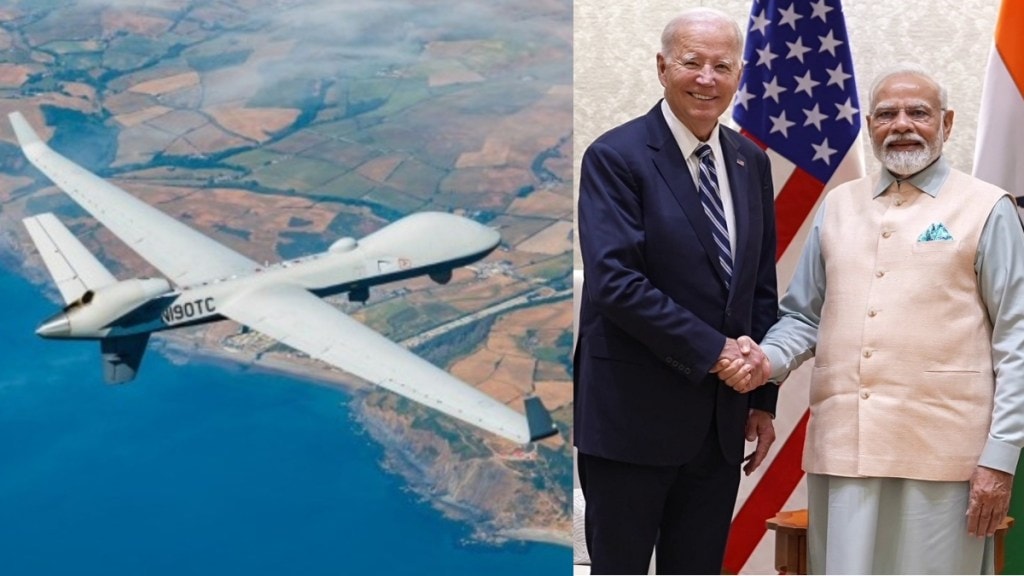At the bilateral meeting between US President Joe Biden and Prime Minister Narendra Modi, significant advancements were made in defence cooperation, with India’s impending procurement of 31 General Atomics MQ-9B remotely piloted aircraft being a focal point.
This acquisition, alongside broader defence agreements outlined in the fact sheet issued by the White House, highlights the evolving strategic partnership between the two nations.
MQ-9B Drone Procurement: A Game-Changer for India’s ISR Capabilities
India’s decision to acquire 31 MQ-9B drones, including 16 Sky Guardian and 15 Sea Guardian variants, marks a significant leap in its defence modernization. The US Congress in February this year approved the deal, which is expected to be finalised by the end of this year. Valued at approximately $3.99 billion, the acquisition is being facilitated through the Foreign Military Sales (FMS) program, a government-to-government framework that simplifies defence transactions between India and the US.
As reported previously in Financial Express Online, the MQ-9B drones will drastically boost India’s intelligence, surveillance, and reconnaissance (ISR) capabilities across multiple domains. These long-endurance, armed drones are recognized for their precision and ability to operate in high-threat environments. By strengthening India’s ISR capabilities, particularly along the Line of Actual Control (LAC) with China and in the Indian Ocean, the MQ-9B drones will enhance national security and regional stability.
Dr Vivek Lall: The Architect Behind the Deal
A key figure in facilitating the MQ-9B procurement is Dr Vivek Lall, Chief Executive of General Atomics Global Corporation. Dr Lall’s efforts have been instrumental in securing the release of these advanced drones to India, a landmark development in US-India defence relations. His role in enhancing defence trade between the two countries underscores the strengthening ties between their defence industries.
He has been at the forefront of negotiations for India’s acquisition of 31 MQ-9B drones, which will see 15 Sea Guardians delivered to the Indian Navy, while the Indian Air Force (IAF) and Indian Army (IA) will each receive eight Sky Guardians. These drones will be vital for monitoring India’s coastal regions and maritime borders, enhancing national security in the Indo-Pacific.
Advanced Capabilities of the MQ-9B Drone Package
In addition to the MQ-9B drones, the procurement package includes a variety of advanced technologies and weaponry. India will acquire 161 Embedded Global Positioning & Inertial Navigation Systems (EGIs), 35 L3 Rio Grande Communications Intelligence Sensor Suites, 170 AGM-114R Hellfire missiles, and 310 GBU-39B/B Laser Small Diameter Bombs (LSDB). These capabilities will significantly enhance India’s ability to conduct precision strikes and gather critical intelligence, further strengthening its military posture.
Expanding Defense Industrial Cooperation: Sagar Defence Engineering and Liquid Robotics
Beyond the MQ-9B deal, the U.S.-India defence partnership is expanding through deeper industrial cooperation. A key development, as highlighted in the White House fact sheet, is the collaboration between Liquid Robotics, a US-based company, and India’s Sagar Defence Engineering. This partnership focuses on the co-development and co-production of unmanned surface vehicle systems designed to bolster undersea and maritime domain awareness.
This collaboration is part of the broader US-India Defece Industrial Cooperation Roadmap, which aims to expand joint development initiatives in critical defence technologies. The teaming of Liquid Robotics and Sagar Defence Engineering is an important step toward strengthening India’s naval capabilities, particularly in the Indo-Pacific, where maritime security is paramount.
Building a Stronger Defence Supply Chain and MRO Capabilities
India’s defence ecosystem is set to benefit from several recent policy initiatives aimed at improving maintenance, repair, and overhaul (MRO) services. One such initiative, praised by President Biden, is India’s decision to implement a uniform Goods and Services Tax (GST) of 5 percent on MRO services for aircraft and aircraft engine parts. This reform simplifies the tax structure and encourages investment in India’s MRO sector, supporting the country’s ambitions to become a defence MRO hub.
Moreover, the bilateral meeting saw a significant boost in US-India industrial collaboration. Lockheed Martin and Tata Advanced Systems Limited recently signed an agreement to establish a C-130J Super Hercules MRO facility in India. This facility will not only support the Indian Air Force but also service global operators of the C-130J, positioning India as a key player in the global defence MRO market.
Fostering Innovation Through INDUS-X
Another highlight of the US-India defence partnership is the growing collaboration in defence innovation, as demonstrated by the India-US Defence Acceleration Ecosystem (INDUS-X) initiative, launched in 2023. This initiative fosters joint innovation in defence technologies through collaboration between governments, businesses, and academic institutions.
During the recent INDUS-X Summit in Silicon Valley, progress was noted in the partnership between India’s Innovations for Defence Excellence (iDEX) and the US Department of Defense’s Defense Innovation Unit (DIU). A Memorandum of Understanding signed at the summit enhances cooperation between the two entities, paving the way for the development of cutting-edge defence solutions.
A key outcome of the INDUS-X collaboration is the launch of joint challenges focused on critical areas such as Space Situational Awareness (SSA) in Low Earth Orbit (LEO). Additionally, US and Indian companies have been awarded over $1 million to develop technologies related to undersea communications and maritime ISR, emphasising both nations’ commitment to innovation in defence technologies.
Strengthening Military Partnership and Interoperability
US-India military cooperation continues to grow, as evidenced by the recent conclusion of a Memorandum of Agreement on the deployment of Liaison Officers. This agreement will see the first Indian Liaison Officer deployed to US Special Operations Command (SOCOM), enhancing military interoperability between the two countries.
Additionally, India’s most complex bilateral tri-service exercise, TIGER TRIUMPH, was held earlier this year, showcasing the deepening synergy between the two armed forces. The exercise included the first-ever demonstration of the Javelin and Stryker systems, further integrating U.S. defence technologies into India’s military framework.

